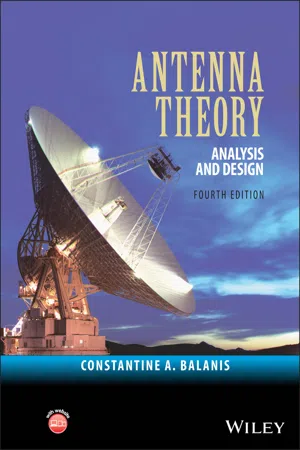
- English
- ePUB (mobile friendly)
- Available on iOS & Android
About this book
Updated with color and gray scale illustrations, a companion website housing supplementary material, and new sections covering recent developments in antenna analysis and design
This book introduces the fundamental principles of antenna theory and explains how to apply them to the analysis, design, and measurements of antennas. Due to the variety of methods of analysis and design, and the different antenna structures available, the applications covered in this book are made to some of the most basic and practical antenna configurations. Among these antenna configurations are linear dipoles; loops; arrays; broadband antennas; aperture antennas; horns; microstrip antennas; and reflector antennas. The text contains sufficient mathematical detail to enable undergraduate and beginning graduate students in electrical engineering and physics to follow the flow of analysis and design. Readers should have a basic knowledge of undergraduate electromagnetic theory, including Maxwell's equations and the wave equation, introductory physics, and differential and integral calculus.
- Presents new sections on flexible and conformal bowtie, Vivaldi antenna, antenna miniaturization, antennas for mobile communications, dielectric resonator antennas, and scale modeling
- Provides color and gray scale figures and illustrations to better depict antenna radiation characteristics
- Includes access to a companion website housing MATLAB programs, Java-based applets and animations, Power Point notes, Java-based interactive questionnaires and a solutions manual for instructors
- Introduces over 100 additional end-of-chapter problems
Antenna Theory: Analysis and Design, Fourth Edition is designed to meet the needs of senior undergraduate and beginning graduate level students in electrical engineering and physics, as well as practicing engineers and antenna designers.
Constantine A. Balanis received his BSEE degree from the Virginia Tech in 1964, his MEE degree from the University of Virginia in 1966, his PhD in Electrical Engineering from The Ohio State University in 1969, and an Honorary Doctorate from the Aristotle University of Thessaloniki in 2004. From 1964 to 1970, he was with the NASA Langley Research Center in Hampton, VA, and from 1970 to 1983, he was with the Department of Electrical Engineering of West Virginia University. In 1983 he joined Arizona State University and is now Regents' Professor of Electrical Engineering. Dr. Balanis is also a life fellow of the IEEE.
Frequently asked questions
- Essential is ideal for learners and professionals who enjoy exploring a wide range of subjects. Access the Essential Library with 800,000+ trusted titles and best-sellers across business, personal growth, and the humanities. Includes unlimited reading time and Standard Read Aloud voice.
- Complete: Perfect for advanced learners and researchers needing full, unrestricted access. Unlock 1.4M+ books across hundreds of subjects, including academic and specialized titles. The Complete Plan also includes advanced features like Premium Read Aloud and Research Assistant.
Please note we cannot support devices running on iOS 13 and Android 7 or earlier. Learn more about using the app.
Information
Table of contents
- Cover
- Title Page
- Copyright
- Dedication
- Preface
- About the Companion Website
- Chapter 1: Antennas
- Chapter 2: Fundamental Parameters and Figures-of-Merit of Antennas
- Chapter 3: Radiation Integrals and Auxiliary Potential Functions
- Chapter 4: Linear Wire Antennas
- Chapter 5: Loop Antennas
- Chapter 6: Arrays: Linear, Planar, and Circular
- Chapter 7: Antenna Synthesis and Continuous Sources
- Chapter 8: Integral Equations, Moment Method, and Self and Mutual Impedances
- Chapter 9: Broadband Dipoles and Matching Techniques
- Chapter 10: Traveling Wave and Broadband Antennas
- Chapter 11: Frequency Independent Antennas, Antenna Miniaturization, and Fractal Antennas
- Chapter 12: Aperture Antennas
- Chapter 13: Horn Antennas
- Chapter 14: Microstrip and Mobile Communications Antennas
- Chapter 15: Reflector Antennas
- Chapter 16: Smart Antennas
- Chapter 17: Antenna Measurements
- Appendix I:
- Appendix II:
- Appendix III: Cosine and Sine Integrals
- Appendix IV: Fresnel Integrals
- Appendix V: Bessel Functions
- Appendix VI: Identities
- Appendix VII: Vector Analysis
- Appendix VIII: Method of Stationary Phase
- Appendix IX: Television, Radio, Telephone, and Radar Frequency Spectrums
- Index
- EULA